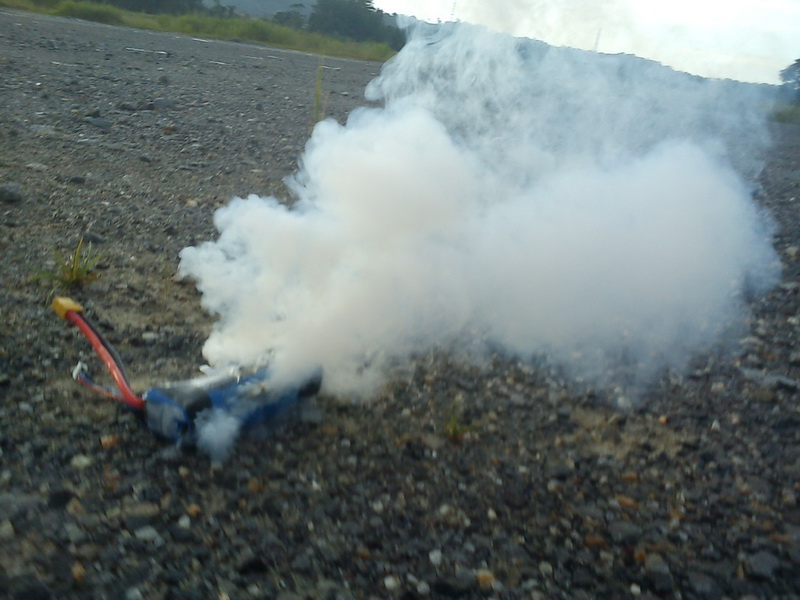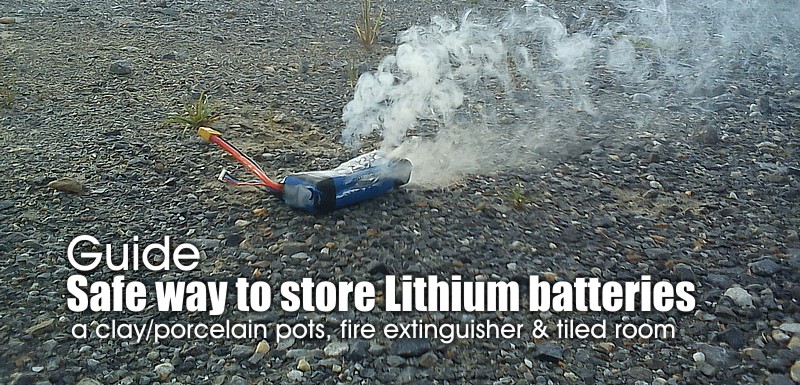
About
Its quite a shock to see almost 95% of R/C hobbyist still doesn't know how to store hazardous lithium polymer (li-po) and lithium-ion (li-on) battery safely and properly at home. Years of experience handling, building and modding battery especially li-po and li-on packs taught me never to trust manufacturing quality (QC standard) and never underestimate the combustion power even on a small 1 cell li-po battery pack. Year 2010 is the peak where li-po battery becomes popular option to deliver high power performance to R/C model especially planes which over shadow the use of lesser 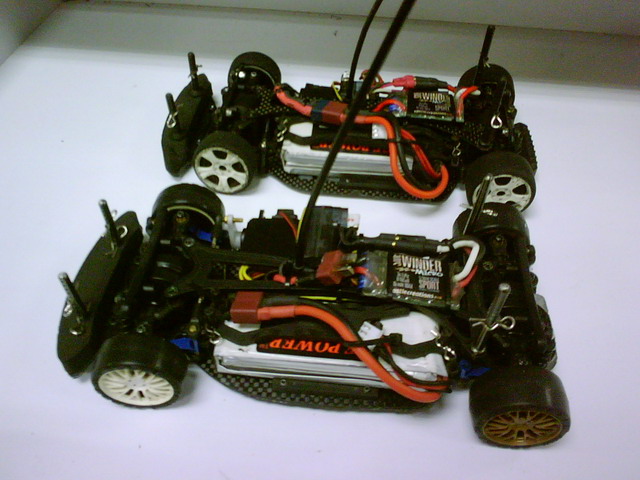 power battery the 'nickel metal hydride' (NiMH) battery which used to be very popular in the 90's. Today rechargeable cylindrical NiMH battery still popular choice for today powering common portable house hold electric appliance like portable fan, radio, table clock and etc which normally in a form of rechargeable AA size battery but lesser use on R/C model due to lower discharge rating and smaller capacity. To this day NiMH popularity is dwindling but some pro level R/C model that still uses NiMH on AAA battery which is the mini 1/24 scale KYOSHO MINI-Z or on budget radio transmitter that powered on AA battery such as the one i used right now is the FLYSKY FS-i6X and GT-3B. previously NiMH battery used to be popular on 1/10th electric R/C but will never out perform the powerful Nitro/gas engine powered models which is why in the 90' until year 2005 the nitro and gas engine models was go to option to enjoy true R/C hobby experience especially R/C flying models. The use of Li-po battery started to gain momentum in 2010 with the advent introduction of 'brushless motor and ESC' technology by 2010 and the rise of mass production of li-po manufacturing in China. With improvement over higher Li-po battery capacity and high current discharge rate electric R/C model can now out perform fuel power model such as nitro and gas engine by double and more with speed, runtimes and increase motor torque power.Charging rate with Li-po increased too. Its was also the time where most R/C flight models such as planes and helicopter started to adopt electric brushless motor both bigger and smaller models made possible thanks to Li-po power technology. Li-on battery comes in later in R/C spotlight by 2015.
power battery the 'nickel metal hydride' (NiMH) battery which used to be very popular in the 90's. Today rechargeable cylindrical NiMH battery still popular choice for today powering common portable house hold electric appliance like portable fan, radio, table clock and etc which normally in a form of rechargeable AA size battery but lesser use on R/C model due to lower discharge rating and smaller capacity. To this day NiMH popularity is dwindling but some pro level R/C model that still uses NiMH on AAA battery which is the mini 1/24 scale KYOSHO MINI-Z or on budget radio transmitter that powered on AA battery such as the one i used right now is the FLYSKY FS-i6X and GT-3B. previously NiMH battery used to be popular on 1/10th electric R/C but will never out perform the powerful Nitro/gas engine powered models which is why in the 90' until year 2005 the nitro and gas engine models was go to option to enjoy true R/C hobby experience especially R/C flying models. The use of Li-po battery started to gain momentum in 2010 with the advent introduction of 'brushless motor and ESC' technology by 2010 and the rise of mass production of li-po manufacturing in China. With improvement over higher Li-po battery capacity and high current discharge rate electric R/C model can now out perform fuel power model such as nitro and gas engine by double and more with speed, runtimes and increase motor torque power.Charging rate with Li-po increased too. Its was also the time where most R/C flight models such as planes and helicopter started to adopt electric brushless motor both bigger and smaller models made possible thanks to Li-po power technology. Li-on battery comes in later in R/C spotlight by 2015.
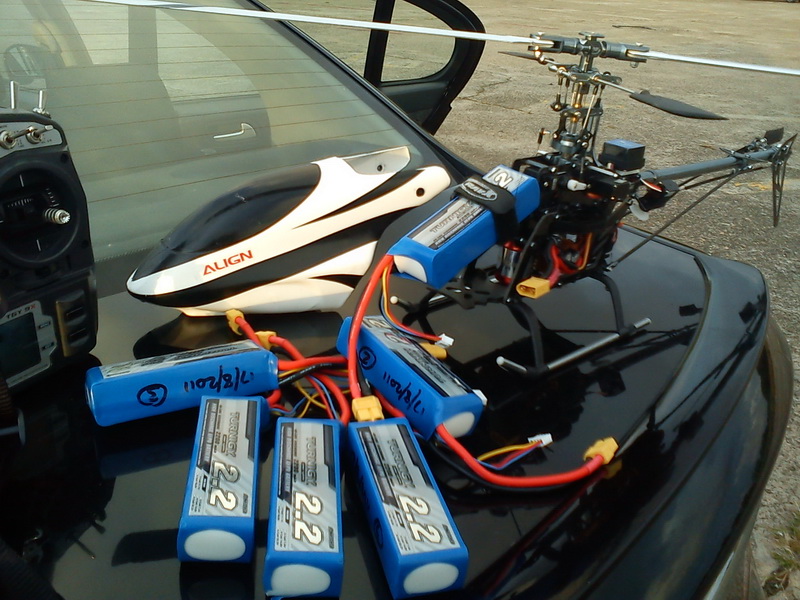
The hazard
What makes Li-po battery popular for us R/C modeler is because of 4 critical factor; lightweight, high voltage, high capacity and high current discharge rate in a small package as depicted below:
-
Lightweight; lighter than NiMH battery pack.
-
Higher voltage; Li-po battery per-cell is 3.7v nominal (4.2V when full charged) while NiMH per-cell is 1.2v only.
-
High capacity; as shown on battery pack as MAH rating (milliamp-hour) which means One ampere-hour (or amp-hour or Ah) is a current of one ampere flowing for one hour.
-
High discharge rate; as shown on battery pack as 'C' rating. A 'C' rating is a measure of the rate at which a battery is discharged relative to its maximum capacity. For example a 1C rate means that the discharge current will discharge the entire battery in 1 hour. This means a battery with a capacity of 100 Amp-hours, this equates to a discharge current of 100 Amps.
Li-on battery however lacks of High discharge rate (4) but achieve better in higher capacity in small lightweight compact size form when compare against Li-po battery. However on both battery the point 2, 3 and 4 above are what makes the battery more hazard if not properly stored. Li-po burst into fire commonly happen all around the globe and their safety standard always been shady depending on manufacturing QC. If you've crashed hard your R/C models into wall at high speed or towards ground you've definitely witness smokes leaking off from battery Li-po cell pack once in a lifetime as R/C hobbyist. Well at worst case it did happened to my crashed model where mad gush of flames came out from lipo pack spitting fumes and fires and that's it, fortunately Li-po pack never explodes like fire cracker as rumored by fear monger. There are tonnes of videos on social media platform such as Youtube shows Li-po battery combust into flame in every occasion and at worst someone's hangar, room or shed gone into flames and burnt down. Some even made some serious headlines where commercial civilian plane crashed because of lithium battery combust onboard the plane....just watch on 'Air Crash Investigation' on Youtube send some chills down your spine....btw if you're an FPV pilot its a good show to watch. However Lithium Ion (Li-on) type battery known to explode in some occasion unlike fire gushing Li-po battery pack because it has higher capacity in one small battery cylinder in Li-on than on Li-po which is why you see many E-cigarette or Vape smoker devices exploded unexpectedly. All this happens because of improper use of Lithium battery.
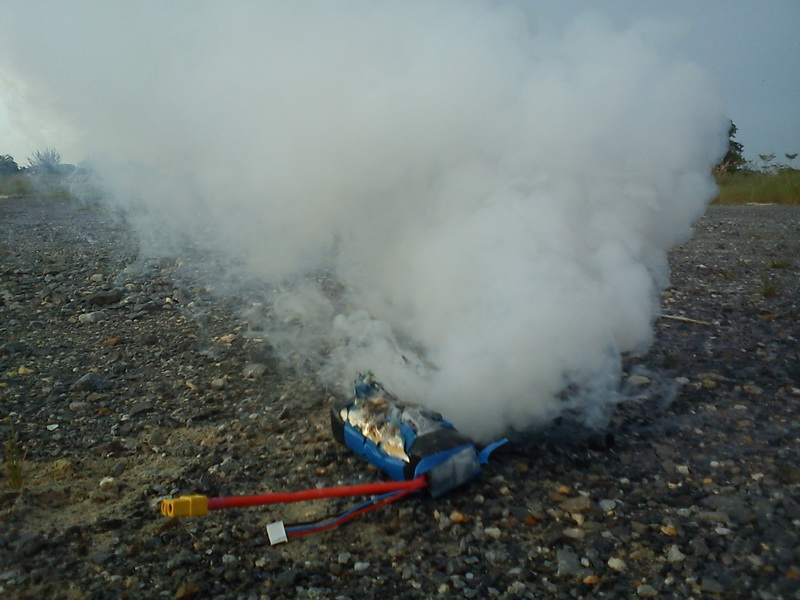
What makes it combust/explode suddenly during storage?
There are lots of ways a lithium polymer combust into fire or lithium ion explode. Since we are talking about these battery for R/C hobby use i'll point out the commonly related issues that happens on our battery as far from what i've experienced before. Below are some points why some lithium battery that we store goes wrong:
-
Shoddy QC battery wire soldering.
Battery li-po consist several cell pack soldered together to make up the battery voltage required. For example; a 7.4V nominal voltage battery made out of 2x cell pack of 3.7V per-cell soldered together. Common ones are 11.1V battery pack made from 3x 3.7V cell. The more cell pack soldered together to make a higher voltage battery the higher amount of soldering work manufacturer to put them together which include soldering thick high amperage wires and also some 'balancing' charge plug all cramped together in compact tight space....very tight. Unfortunately some soldering have 'cold soldering' meaning the solder joints may cracked because improper solder cooling which is common on fast manufacturing lines. When the soldered wire joint cracked it will came loose and touch other parts of the wires or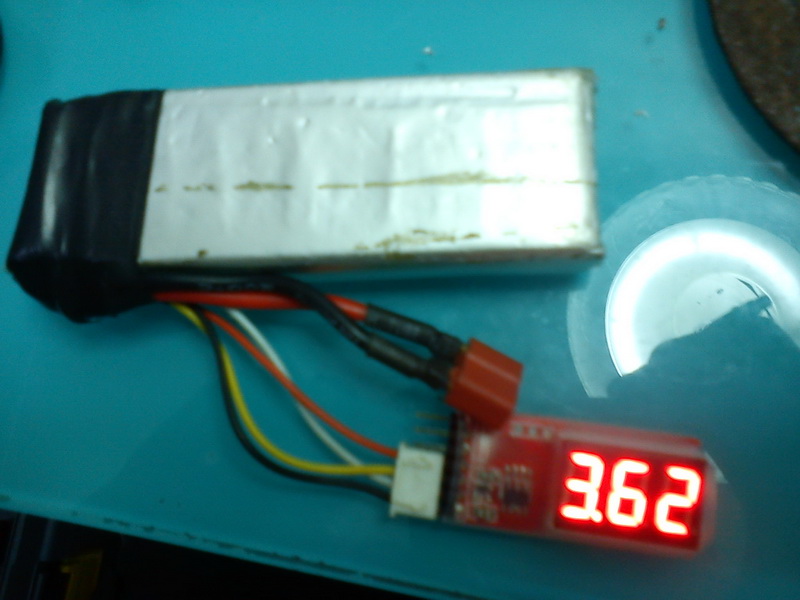 battery terminal inside the battery wrapper causes electric shorts, soarks then goes over heat and burned! Worst case i found out during disassembly of my li-po battery is some solder have loose 'pebble' like soldering blob wondering loosely inside the wrapper due to fragments of 'cold soldering' or rush soldering practices. This loose wondering solder pebble will likely to move about inside the battery wrapper shorting two battery terminal at any random time potentially will causes shorts, overheating and finally burned. If you are brave enough try open the battery wrapper near the soldered wire terminal to inspect the soldering quality. Almost 10% of my li-po battery batch have QC problem with soldering waiting for the right time to get short circuit by loose wires or bad factory solders. I had a video on my Youtube when i try to remove one dead Li-po cell pack i notice fragments of soldering debris moving about on the battery terminal almost waiting to be shorted! Sometimes on new battery of you notice one cell does not show any voltage that doesn't mean the cell pack is dead, 100% its more likely the wire cut off from the terminal which is fixable if you're handy with soldering tools.
battery terminal inside the battery wrapper causes electric shorts, soarks then goes over heat and burned! Worst case i found out during disassembly of my li-po battery is some solder have loose 'pebble' like soldering blob wondering loosely inside the wrapper due to fragments of 'cold soldering' or rush soldering practices. This loose wondering solder pebble will likely to move about inside the battery wrapper shorting two battery terminal at any random time potentially will causes shorts, overheating and finally burned. If you are brave enough try open the battery wrapper near the soldered wire terminal to inspect the soldering quality. Almost 10% of my li-po battery batch have QC problem with soldering waiting for the right time to get short circuit by loose wires or bad factory solders. I had a video on my Youtube when i try to remove one dead Li-po cell pack i notice fragments of soldering debris moving about on the battery terminal almost waiting to be shorted! Sometimes on new battery of you notice one cell does not show any voltage that doesn't mean the cell pack is dead, 100% its more likely the wire cut off from the terminal which is fixable if you're handy with soldering tools. -
Loose heat shrink.
Li-po battery have two thick high amp wires known as the positive (Red) and ground (Black) wires going out to female plug more commonly on either XT60 or Dean T. Wires to these connector always been solder then exposed silver soldered parts have heat shrink tubes to protect external element from shorting two nearby terminals. Overtime two side by side heat shrink tube will get loose and exposed the soldered terminal. During storage some conductive element may touched these two exposed terminal and shorted the battery. -
Loose balance charging plug wire pin or loose JST plug.
Li-po battery and Li-on battery have a small JST balance charging connector with small gauge wires along. These are used to balance charge the cell individually especially anything beyond 2s,3s, 4s and above. Repeated plug and un-plug to the balancing charging port causes some pin inside to came out loose and also flexing the small wires repeatedly causes some internal wire strand to frayed. If two nearby side by side balance charging pin loose it will jump into other side and shorted he pins. But most common shorts came from frayed wiring from strands of wires loose from the pin socket then touching next pin on the same row causing 'silent' current short. If you notice you're having random voltage popping up in either one of your lipo battery cell on your charger display monitor then its time to check those wires and pins. -
Over stretched balance charge wire.
When repeatedly using the battery by pulling the balancing wires out from your model battery compartment to connect to your battery checker or a way to yank the battery out from the models its highly likely the wire outer rubber/plastic wire insulation might be stretched out (skirt up) from the battery casing leaving the inner wire exposed and wiggle around inside the battery protective wrapper. As it wiggle around with exposed (un-insulated wire) it will tangle with near by balancing wires and instantly shorted the battery cell. This happens a lot on old battery (repeatedly battery usage). So be aware when you pull the battery balancing wire by hand. -
Plug shorted with nearby conductive element
This one happens the most common problem and much ignored safety either on new or old battery. 90% of our R/C hobby members i met does that to store their Li-po battery even with NiMH battery too. Battery female plug connector usually left open without cover which is common but not much concern. However most people will store their battery inside their pocket, boxes, or tool bag along with some little items that made from electric conductive materials such as wires, paper clips, metal tools, coins, screws, metal rods and other conductive material. These material may accidentally touch both battery positive and ground terminal on the plug may causes electric shorts/sparks then lead to burns! Unfortunately not everyone born with common sense. -
Store inside conductive storage/tin.
You know what happens when two positive (+) and ground (-) battery terminal connected or shorted with conductive metal paper clips.....exactly sparks and burns! Unfortunately some people even long experience R/C hobbyist still put their Li-po and Li-on battery inside un-insulated big tin of biscuit thinking its a fire proof...but they forgot tin conduct electricity. Luckily battery plugs are designed to have extra buffer of space away between conductive battery terminal and most outer end of the connecting plastic to avoid direct contact with external element head first. However over time those buffer may shift about due to worn and loose connector. Bad move buddy.
So the above points are most common thing to happen that causes Li-po battery to short and combust into flames during storage. There's other factor not taken into account that influence the li-po battery to catch fire such as exposure to heat or punctured pack but it not likely to happen during storage period.
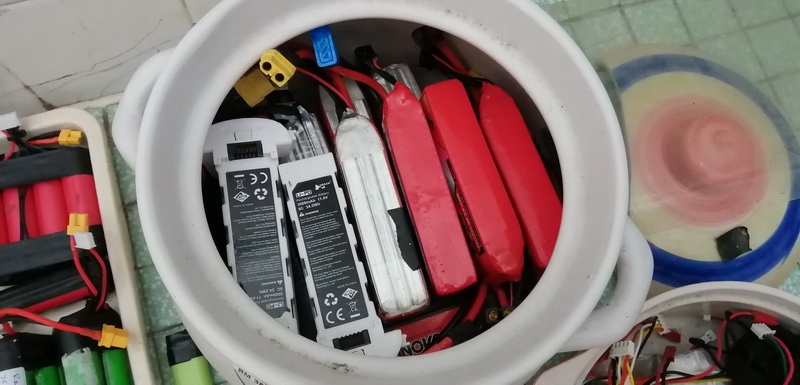
Best material to store battery at home..clay pot!
There's always 101 ways to store your lithium battery safe. But the best, safest, 100% effective, cheapest and easiest way is using ceramic pot or pot made of clay to store bulk of lithium battery because its thicker, non conductive and good heat insulator and electric insulator plus they are cheap and can be found at any store. Ceramic & clay pots?..don't worry about those details they are both came from same thing. Clay is made from natural organic material from the ground/solid...mother natures stuff. Ceramic comes from clay but its made with extra glaze coating to make it looks beautiful which gave its name Ceramic...its harder and rigid than in clay form. Other names such as Porcelain, Stoneware, clay flower vase and potter comes from clay....so they are good stuff to store Li-po and Li-on battery in it. If you've been into Art classes in school you're more likely have played around with clay. Even NASA space shuttle uses ceramic tiles of clay under their space shuttle to prevent extreme heat when entering earth atmosphere.
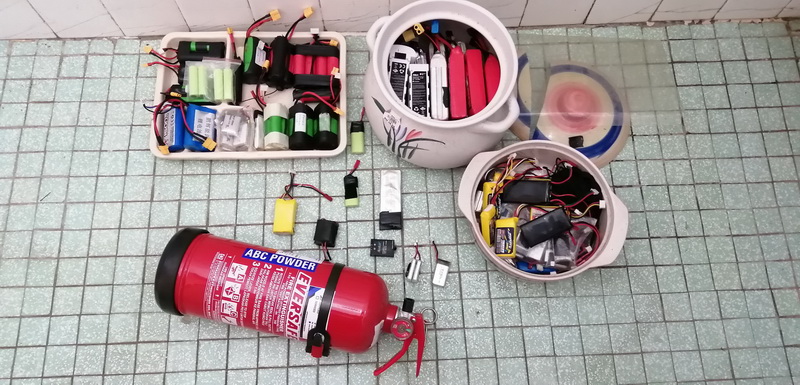
How to store safely at home
Below some tips how i store my Li-po and Li-on battery.
-
Using clay/porcelain pot and tray
As mentioned before they are good source of fire and heat insulator able to encapsulate/ contain huge amount fire incase lithium battery go bust. Thicker walled clay pot with vents are ideal for keeping high voltage lithium battery and enough to vent out the pressure. You can also use big thick porcelain clay tray to put explosive battery such as Li-on too. -
Store inside ceramic tile room...bath room
If you live in an apartment or high storey building with no outdoor shed to store your battery away from crowded house hold you can also store safely and ideally inside a 'dry' and 'unused' bathroom since the wall and floor are covered with ceramic tiles which give good protection and insulation against lithium battery fire and heat from spreading across places, just make sure to stay away from burning prone material such as door panels. The bathroom also must have windows for proper venting. If you don't have 'unused' bathroom then a house balcony or corridor surrounded with empty space of concrete floor and wall is a good place to store your battery too. Make sure when store both in tiled bathroom or concrete balcony/corridor the battery first must be store in or on the clay/ceramic pot for fire proofing enclosure. -
Standby fire extinguisher (ABC/BC, Class-D Dry powder extinguisher).
As an R/C modeler hobbyist its is always important to have fire extinguisher standby both at home and portable ones for outdoor use since both li-po/li-on battery and even fuel powered models like nitro and gas can posed a fire hazard during accident. But first priority having one at home close to battery storage is a must have! ABC or BC type fire extinguisher is the most suitable to put off lithium battery fire. Must use 'CLASS D' dry powder fire extinguisher to serve this purposes.
*Extra note: Fire extinguisher equipment must be sent for inspection and maintenance to the vendor/provider annually to make sure the canister is well pressurized and certified to be use.
As listed above that's how i store all my bulks of lithium polymer and lithium ion battery both after market and custom build ones. Not only i stored my R/C models based batteries but also some cameras, TV remote, phones and other appliances that uses Lithium batteries too.
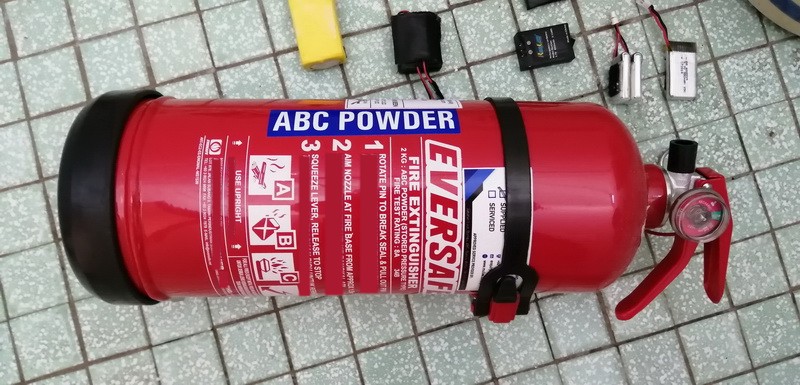
Argument of using tin/metal box versus ceramic/clay pots
SoSome might argue its better to use metal box or tin to store lithium battery but they forgot two things; some metal conduct electricity and metal/tins conduct heat. We have discussed metal/tin conduct electricity especially non insulated metal but the biggest problem is they conduct heat so well...too well that is why they are the best heatsink and radiators.....i translate that as another bad news. Imagine if Li-po or Li-on battery do combust into fire of inferno inside the metal/tin box it will eventually generate huge amount of encapsulated heat. Metal/tin material conduct heat so if the metal/tin box placed on wooden floor or nearby wooden furniture the heat will expand and heating nearby item causes the surrounding to scorched with burns. Ceramic and clay pots however are extremely good insulator that prevents heats from dissipating outwards. That's why people cook food in ceramic or clay pots and you still can touch outer pot without skin scorching. The only cons with ceramic and clay; they are heavy and brittle but that won't be much issues because you don't move the ceramic/clay pot about when storing the battery since they just stay inside the house or sheds.
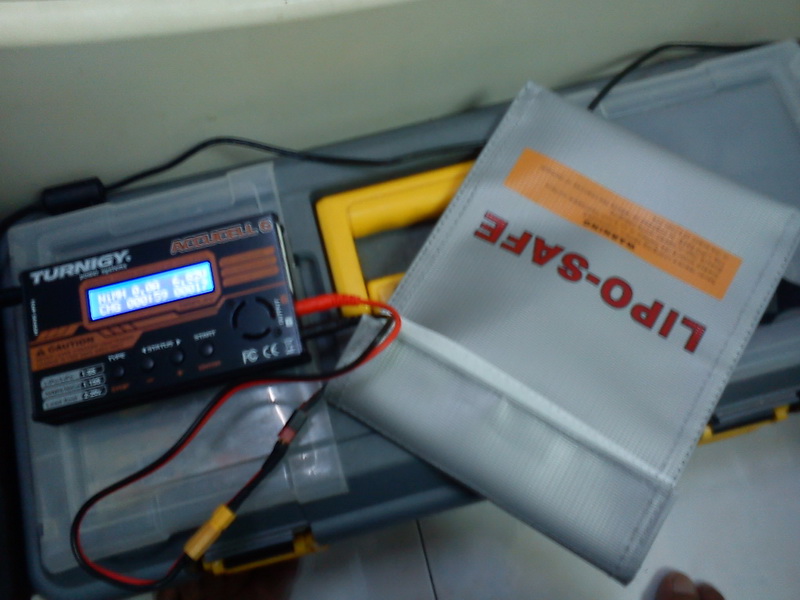
Lithium Polymer fire proof bag?
I I have those too but the are only good for transporting battery from one place to another in short period of time but not a permanent solution to store battery at home because they hold few battery and design to minimized fire during transport. Also they could only be used once after the fire. They designed to encapsulate small quantity of fire and vent/exhaust out the heat towards outer side of the bag which is not a good thing since it will spew heat and fires to nearby furniture, floor or wall inside the room when venting out the bag pressure which still results of fire scorching nearby. Plus some bag will melt due to heat and some internal fabric made from glass fiberous material claim to be fire proof but actually its a hazards asbestos material with a different name....bad for lungs. I had old Li-po bags with asbestos fiber all over my hands and living room, not good!

Summary
So there you go all the tips and trick how to store lithium battery without burning hole in your pocket and without risking burning your own living space. Unfortunately this is the least discussed topic and most neglected issues among R/C hobbyist when storing 'world most dangerous batteries' which causes much fire hazard to living space that all modeler should learn....actually its a common sense to know that battery is a combustible and sometimes explosive. So if you read this and has done nothing to practice safe battery storage then its time for you to find a clay pottery or as simple as a clay flower vase to store your Lithium battery in proper space away from combustible item nearby as soon as possible. Remember.... Battery fire is real! Enjoy the hobby and be safe!
